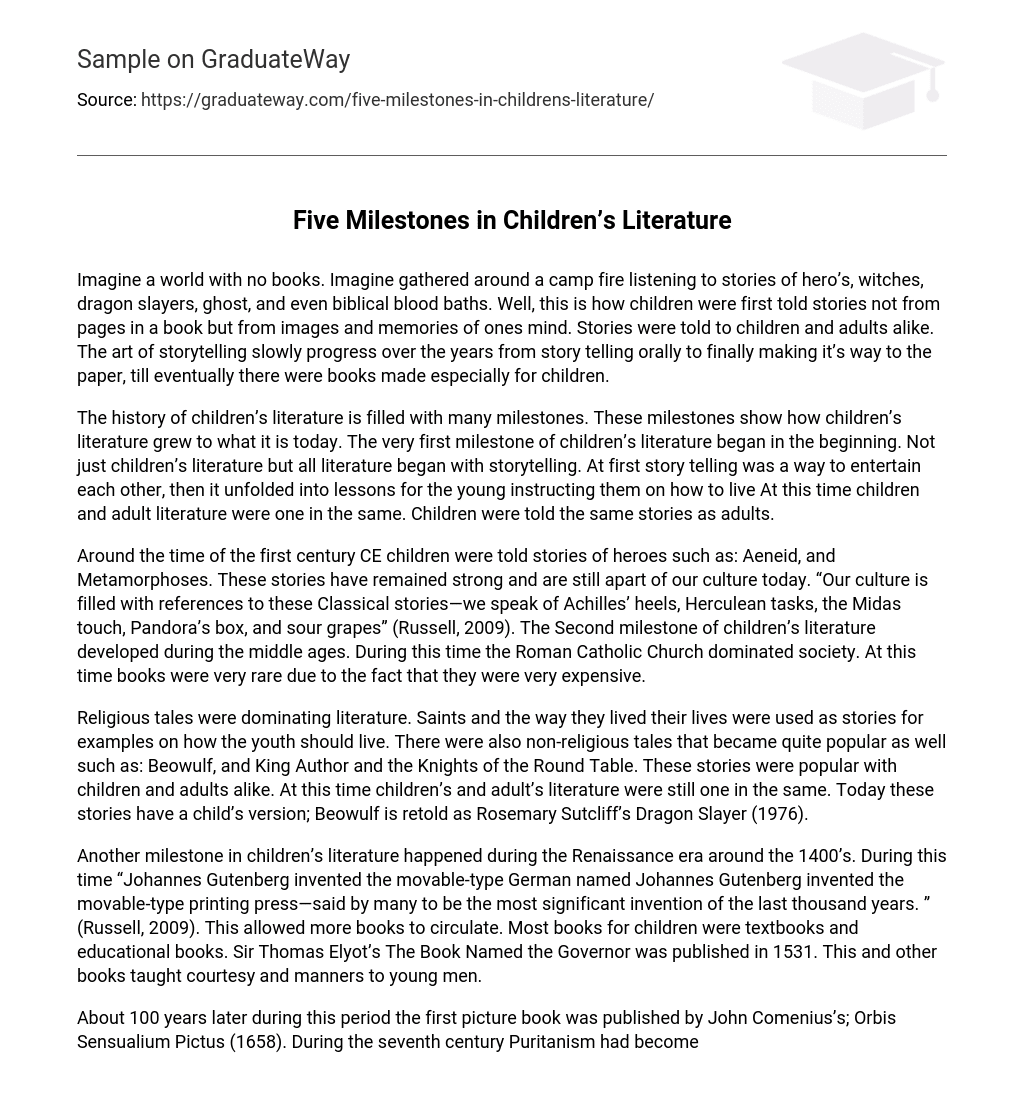Imagine a world with no books. Imagine gathered around a camp fire listening to stories of hero’s, witches, dragon slayers, ghost, and even biblical blood baths. Well, this is how children were first told stories not from pages in a book but from images and memories of ones mind. Stories were told to children and adults alike. The art of storytelling slowly progress over the years from story telling orally to finally making it’s way to the paper, till eventually there were books made especially for children.
The history of children’s literature is filled with many milestones. These milestones show how children’s literature grew to what it is today. The very first milestone of children’s literature began in the beginning. Not just children’s literature but all literature began with storytelling. At first story telling was a way to entertain each other, then it unfolded into lessons for the young instructing them on how to live At this time children and adult literature were one in the same. Children were told the same stories as adults.
Around the time of the first century CE children were told stories of heroes such as: Aeneid, and Metamorphoses. These stories have remained strong and are still apart of our culture today. “Our culture is filled with references to these Classical stories—we speak of Achilles’ heels, Herculean tasks, the Midas touch, Pandora’s box, and sour grapes” (Russell, 2009). The Second milestone of children’s literature developed during the middle ages. During this time the Roman Catholic Church dominated society. At this time books were very rare due to the fact that they were very expensive.
Religious tales were dominating literature. Saints and the way they lived their lives were used as stories for examples on how the youth should live. There were also non-religious tales that became quite popular as well such as: Beowulf, and King Author and the Knights of the Round Table. These stories were popular with children and adults alike. At this time children’s and adult’s literature were still one in the same. Today these stories have a child’s version; Beowulf is retold as Rosemary Sutcliff’s Dragon Slayer (1976).
Another milestone in children’s literature happened during the Renaissance era around the 1400’s. During this time “Johannes Gutenberg invented the movable-type German named Johannes Gutenberg invented the movable-type printing press—said by many to be the most significant invention of the last thousand years. ” (Russell, 2009). This allowed more books to circulate. Most books for children were textbooks and educational books. Sir Thomas Elyot’s The Book Named the Governor was published in 1531. This and other books taught courtesy and manners to young men.
About 100 years later during this period the first picture book was published by John Comenius’s; Orbis Sensualium Pictus (1658). During the seventh century Puritanism had become one of the influences on children’s literature. The puritans held reading in high regard. They believed that not only the bible but education in general should be available for everyone. The puritans are credidted with encouraging literacy among the middle classes. (Russell, 2009). In order to use any of these you would need to know how to read.
School was important to the puritans and it was an important part of the children’s lives. There were a variety of schoolbooks available to school children. The greatest influence on children’s literature along with the puritans was John Locke an English philosopher. In 1693 he wrote an essay Thoughts Concerning Education. John’s philosophy was that children’s minds were blank slates waiting to be filled up and it was the adult’s job to provide the proper education and learning environment for them to reach their full potential.
This concept is still a major philosophy in today’s society. The fifth most important milestone in children’s literature came along in the late eighteenth and early nineteenth centuries. Finally literature made just for the children. John Newbery was the first to public a children’s book. The book titled A Little Pretty Pocket Book was published in 1744. This was a major milestone for children’s literature, these books were written specifically for the entertainment of children. This opened doors and gave birth to a new world of literature, children’s literature.
Later along came the famous folktales. The brothers Grimm have published many folktales’ that are still a major part of literature today. Eventually this lead to romantic and fantasy stories like Lewis Carroll’s Alice’s Adventures in Wonderland this is still very popular today. Children’s literature has traveled a long road since the beginning when children and adults were gathered around the fire listening to tales. Today there are numerous numbers of books for children. Not only are there new stories being published daily but the classics from centuries ago are still among us.
Stories are not only to entertain the children but they are to teach lessons as well. Reading is has become an important part of everyone’s lives, and children especially. Children are our future and literature is what will open their minds and prepare them for the world.
References:
Russell, D. L. (2009). Literature for children: a short introduction (6th ed. ). Boston, MA: Pearson. Leary, B. E. (1970). Lirary of University of Iowa. University of Iowa. Retrieved from http://www. lib. uiowa. edu/spec-coll/bai/leary. htm





